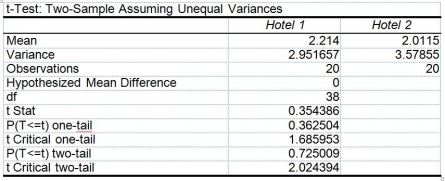TABLE 10-13
The amount of time required to reach a customer service representative has a huge impact on customer satisfaction. Below is the Excel output from a study to see whether there is evidence of a difference in the mean amounts of time required to reach a customer service representative between two hotels. Assume that the population variances in the amount of time for the two hotels are not equal.

-Referring to Table 10-13, what assumptions are necessary for testing if there is evidence of a difference in the variabilities of the amount of time required to reach a customer service representative between the two hotels to be valid?
Definitions:
Labor Productivity
A measure of economic performance that calculates the output produced per unit of labor employed.
Transportation & Shipping
The processes and services involved in moving goods and products from their origin to their destination, using various modes of transport such as trucks, ships, and trains.
Derailed Managers Study
A research study focusing on identifying the reasons why managers fail to achieve their expected career progression or performance.
First-Line Manager
A manager at the lowest level of an organization who directly manages staff and operations.
Q42: The chi-square test of independence requires that
Q87: Referring to Table 9-8, state the alternative
Q88: Referring to Table 11-3, the sporting goods
Q92: The marketing manager for an automobile manufacturer
Q106: Referring to Table 8-10, what is the
Q120: If you wish to determine whether there
Q141: Referring to Table 12-11, the same decision
Q165: Referring to Table 10-3, which of the
Q172: Referring to Table 8-11, we are 99%
Q203: Referring to Table 13-3, suppose the director